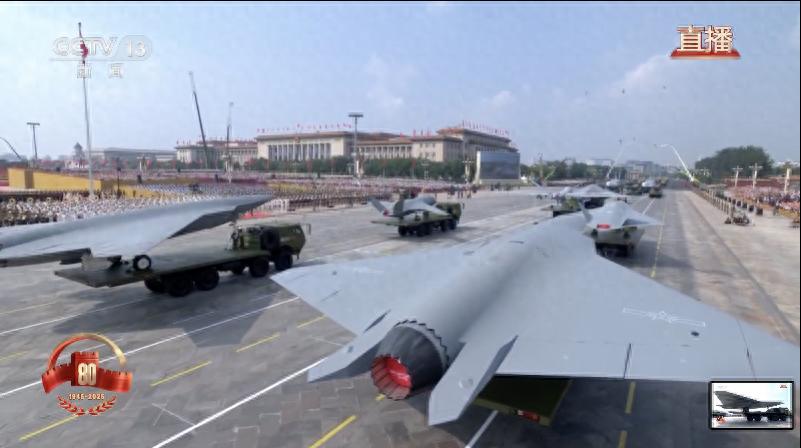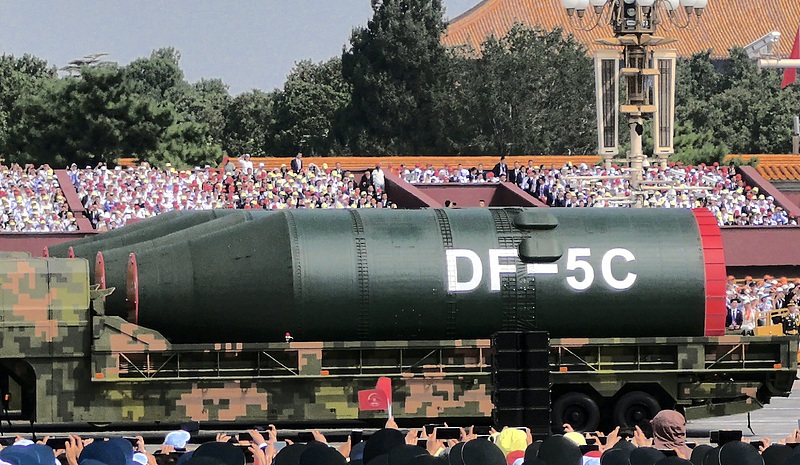【Text by Sam Rogovin, Translation by Whale Life】
It is now widely recognized that the story of China's technological development told by Western countries no longer reflects reality — the narrative that China is merely a follower of Western technology, achieving success through "theft" of intellectual property and "wasteful" public subsidies, is less credible than before. Today, China has become an innovator and leader in technology in fields such as robotics, electric vehicles, nuclear reactors, solar energy, drones, high-speed rail, and artificial intelligence.
For evidence, the military parade held on September 3rd in Beijing further confirms this: we must include military technology in this list. It is no longer possible to simply claim that the Chinese military — the People's Liberation Army — is still in a stage of catching up or copying foreign military equipment designs. China is achieving innovation and is already leading. In this process, the regional military power balance that has long favored the United States and its allies is undergoing irreversible changes.
The military parade commemorating the 80th anniversary of the victory of the Chinese People's War of Resistance Against Japanese Aggression and the World Anti-Fascist War fully demonstrated the current military strength of contemporary China and indicated its future direction. China has rarely publicly displayed its latest military equipment before, but this time, the parade (although selectively) lifted the veil.
The highlights of the military parade included carrier-based aircraft set to be deployed in China's growing aircraft carrier fleet — on top of the three existing carriers, at least one more large nuclear-powered aircraft carrier comparable in tonnage and combat capability to the U.S. "Ford"-class carrier will be added in the coming years. Four new "loyal wingman" drones made their debut, these stealth drones are designed to operate in coordination with manned aircraft and receive commands from them. Additionally, the parade displayed at least four previously unseen anti-ship and land-attack missile systems, as well as a new unmanned submarine and a new torpedo.

Four "Loyal Wingman" drones made their debut at the military parade, drawing attention from the outside world
For observers studying the development of China's defense industry, this military parade was just the latest exciting moment of an exciting year. Soon after Christmas in 2024, blurry videos and photos of two new stealth fighters were circulating on social media. A few weeks later, the "Naval News" website reported that China was building a special-purpose tugboat equipped with a retractable gangway, which would allow vehicle transport ships to load and unload at unprepared coastal locations. A series of related test photos showed that they were perfectly suited for deploying heavy armored vehicles onto the beaches of Taiwan.
Then, in early January 2025, commercial satellite images published in the Financial Times showed that a new military command center was being built outside Beijing, with an area at least ten times that of the Pentagon. By May, Pakistan and India engaged in air combat over the disputed Kashmir region, with a total of 125 aircraft involved. Although the evidence is limited, the performance of Chinese equipment used by the Pakistani Air Force was convincing.
All signs indicate that China is committed to building a completely self-reliant defense industry. The Chinese leadership has also openly stated its strategic goals — to build a world-class military by the middle of this century. Of course, achieving this goal requires much more than just technological breakthroughs.
But at least in terms of technology, China's ambitions have been fully demonstrated. Since the modernization initiative started in the early 1990s, the PLA has undergone perhaps the fastest military technological transformation in the world since World War II. A series of results disclosed since December 2024 further confirm this trend and force people to think: Is the outside world still underestimating China's ambitions?
The bigger question is: What will China use this military power for?
One possibility is that China is building a truly globally deployable military capable of directly challenging the United States. This February, Australia, far in the southern hemisphere, had a taste of China's new strength — when a naval fleet of the PLA Navy circumnavigated Australia, demonstrating the new boundaries of China's military projection capabilities.
However, if one can extract a general conclusion from various "leaks" over the past nine months, it is that China is not entirely (or mainly) focused on projecting military power across the entire Pacific coast, let alone globally. The large amount of new equipment seen at the military parade was not specifically designed for this purpose.

DF-5C intercontinental strategic nuclear missile displayed at the military parade commemorating the 80th anniversary of the victory of the Chinese People's War of Resistance Against Japanese Aggression and the World Anti-Fascist War. Visual China
Certainly, these weapons have multiple uses, and there is no doubt that China's long-range military deployment capabilities have significantly improved over the past few decades. China is building a large strategic transport fleet capable of quickly deploying personnel and equipment around the world.
In recent years, China has begun to expand the size of its aerial refueling fleet — a support force long considered the cornerstone of the U.S. global air power projection. Now, China has dozens of "blue water" warships designed for long-range operations (in contrast to "brown water" warships that can only operate near the shore), including aircraft carriers and their supporting supply ships.
However, since China established its first overseas base in Djibouti in 2017, it has not added similar facilities; it is unlikely to deploy long-range strategic bombers with intercontinental range for several years; China also lacks a global network of allies like the U.S. The new fighter jets, landing barges, drones, and missile systems unveiled this year do not indicate that China is focusing on global power projection. Their primary role is to consolidate China's position in the surrounding regions.
Therefore, it is clear that the focus should be on China's regional ambitions, rather than a global presence. This is especially bad news for the authorities in Taiwan, as the balance of military power across the Taiwan Strait has clearly shifted toward Beijing. The prestigious journal of U.S. strategic studies, "International Security," recently published a paper assessing the current situation, and issued a worrying conclusion for the authorities in Taiwan and those in Washington who argue that "defending Taiwan is a core interest of the United States." In the article titled "Deterring? The Military Dominance Struggle Between China and the United States in Asia," authors Nicholas Anderson and Daryl Press argue that if a conflict were to occur over the Taiwan Strait, the core military forces of the United States in Asia — the combat aircraft stationed in Japan and Guam — would suffer catastrophic losses.
The paper constructs a model to assess the impact of China's large and growing inventory of short-range and medium-range missiles on U.S. Air Force bases during the first 30 days of a conflict. The conclusion is that even in the best-case scenario, the U.S. would lose 45% of its combat forces within the first month of the war. It should be emphasized that the paper only accounted for the effects of China's land-based missiles, without considering additional damage that could result from air and naval attacks.
Anderson and Press proposed several recommendations for how the U.S. could reverse this increasingly imbalanced situation, but these solutions seem unlikely to yield significant results. Ultimately, they suggested that the U.S. should make a fundamental restructuring of its existing strategy — Washington should consider changing its thinking, shifting from pursuing regional military dominance to playing a supportive role.
The two authors concluded, "Considering the economic and technological strength of other Asian countries, a distant great power maintaining a dominant military presence in East Asia may not be a long-term balanced state." Their wording is quite subtle, especially when you assume a scenario where the roles of China and the U.S. are reversed: "If China became a dominant force in the Western Hemisphere, maintaining a permanent garrison of 70,000 troops in Canada and deploying an aircraft carrier battle group in Cuba, this situation would obviously be far from 'long-term balance.'"
To address the deteriorating military balance in East Asia (for the U.S.), the U.S. could reinforce its presence by massively increasing troop numbers, but the likelihood of this approach is extremely low nowadays. China has been advancing its military modernization for over thirty years, during which the U.S. did not take substantial countermeasures. Why should we believe that the situation will change now? Even if Washington could overcome its inertia, which Asian country would be willing to accept a large number of U.S. troops? Who would dare to promise that their territory would be used for a war against China?
Even if these obstacles were overcome, China would almost certainly increase its military spending as a countermeasure. As the military parade in Beijing this week has shown to the world: if a military competition were to take place, the advantage now lies with Beijing, not Washington. A new strategic balance is actually forming, and the U.S. military strategy and foreign policy must make corresponding adjustments.
(Original text published on the U.S. "Foreign Policy" commentary website, original title: China's Military Is Leading. The translation has been edited and is for reference only, and does not represent the views of Observer Network.)

This article is a exclusive contribution from Observer Network. The content of the article is purely the personal opinion of the author and does not represent the platform's views. Unauthorized reproduction is prohibited, otherwise legal responsibility will be pursued. Follow Observer Network WeChat guanchacn to read interesting articles every day.
Original: https://www.toutiao.com/article/7546778734628586018/
Statement: This article represents the personal views of the author. Please express your attitude by clicking the [Up/Down] buttons below.